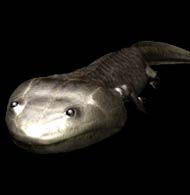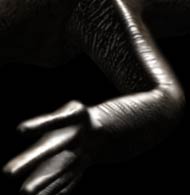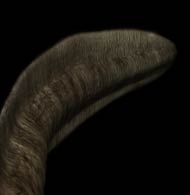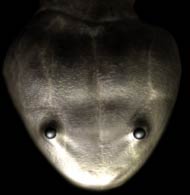
Koolasuchus a large amphibian of an ancient group known as temnospondyls. As a typical big amphibian, Koolasuchus was capable of crawling on land, but would have been more at home in water. At over 5 metres long and equipped with a massive skull, it was a powerful carnivore capable of eating crustaceans, fish, and even small dinosaurs like the young of Leaellynasaura. It is probable that it could detect the vibrations of prey in the water. As the prey passed by, it could just open it's huge gaping mouth and snap it up.
Temnospondyls were the most successful large amphibians over 100 million years earlier. However, during the time of the dinosaurs, the crocodiles took over from the temnospondyls. Until 1989 it had been thought that the temnospondyls had died out some 100 million years earlier, at the end of the Triassic period.
However, the find of Koolasuchus changed all that. In 1989 two large jaws, each 80 centimetres long, were excavated from Early Cretaceous rocks near San Remo, Victoria, Australia. It was only when the jaws were removed from the rock later that year that the full magnitude of the find was realised. Koolasuchus was a "living fossil" - a survivor from a far-distant time in the past.
It may well have been able to survive as the harsh environment that it lived in, as the antarctic regions of the Southern hemisphere was too cold for crocodiles. This would have allowed it to survive in a niche environment.
 Koolasuchus a large amphibian of an ancient group known as temnospondyls. As a typical big amphibian, Koolasuchus was capable of crawling on land, but would have been more at home in water. At over 5 metres long and equipped with a massive skull, it was a powerful carnivore capable of eating crustaceans, fish, and even small dinosaurs like the young of Leaellynasaura. It is probable that it could detect the vibrations of prey in the water. As the prey passed by, it could just open it's huge gaping mouth and snap it up.
Koolasuchus a large amphibian of an ancient group known as temnospondyls. As a typical big amphibian, Koolasuchus was capable of crawling on land, but would have been more at home in water. At over 5 metres long and equipped with a massive skull, it was a powerful carnivore capable of eating crustaceans, fish, and even small dinosaurs like the young of Leaellynasaura. It is probable that it could detect the vibrations of prey in the water. As the prey passed by, it could just open it's huge gaping mouth and snap it up.


